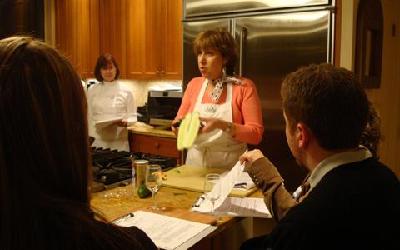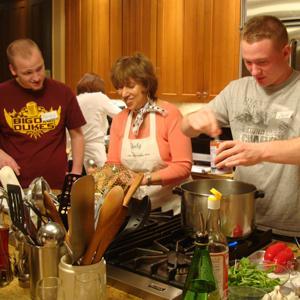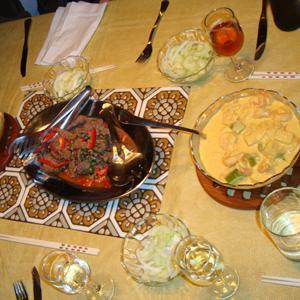
FAITH LAPIDUS: Welcome to THIS IS AMERICA in VOA Special English. I'm Faith Lapidus.
STEVE EMBER: And I'm Steve Ember. This week on our program: Americans sink their teeth into cooking.
(SOUND)
JUDY HARRIS: "The secret here is actually to cut them on the thin side. Some people say you have to be able to read a newspaper through it."
FAITH LAPIDUS: Judy Harris is cutting a cucumber. She was a restaurant chef. Now she teaches cooking classes at her home in Alexandria, Virginia. Tonight her students are learning to cook Thai food.
JUDY HARRIS: "Which is the hottest part of the chili?"
STUDENTS: "Seeds."
JUDY HARRIS: "You got it."
STEVE EMBER: Judy Harris keeps her classes small. That way she can provide more personal attention. She charges 75 dollars for one night to learn how to prepare a full meal.
On this night the class is making a cucumber salad, chicken satay with spicy peanut sauce and stir-fried beef with graprao basil. Also on the menu: Thai shrimp curry with pineapple over jasmine rice. And, for dessert, the students are making ginger ice cream.
After the cooking is done, they sit down to enjoy their creation.

Among the six people in the class are Jeff Van Meter and his friend Danny Becker. Jeff and Danny are both 22 and students at George Mason University in Fairfax, Virginia.
They both love Thai food in restaurants. Jeff's mother was the one who suggested he take the class.
JEFF VAN METER: "She's like, 'Why don't you learn a skill?'"
STEVE EMBER: As they prepare the shrimp, Jeff talks about what he usually cooks when he cooks for himself. Often it means heating up frozen pizzas. Same with Danny.
DANNY BECKER: "It's interesting to actually work with something different than just hamburgers, hot dogs ..."
FAITH LAPIDUS: Cooking classes like this one are just part of America's growing interest in all things related to food.
KATHLEEN COLLINS: "It is sort of like, a cultural pastime that goes beyond mere homemaking instruction."
FAITH LAPIDUS: Kathleen Collins wrote "Watching What We Eat." Her book explores the history of cooking programs on television. She says cooking shows have fed much of today's interest in cooking.

(SOUND)
STEVE EMBER: The Food Network is a cable channel that began in 1993. In just the past two years the Food Network has added more than 20 new programs.
And earlier this year the same company that owns the Food Network launched the Cooking Channel. The Cooking Channel describes itself as "an entertainment brand dedicated to today's passionate food lover."
FAITH LAPIDUS: Cooking programs began on radio. They moved to TV in the 1940s. Those early shows were targeted at housewives -- women whose job was to stay home and take care of the family.
Yet, interestingly, Kathleen Collins says those programs were mainly seen by men. This was before most American homes had their own television. Men saw the cooking shows on TV sets at their neighborhood bar.
Then, in the 1960s and 1970s, Americans became more interested in gourmet cooking. Television chefs like Julia Child helped teach people the fine art of French cooking. That was very popular at the time.
(SOUND)

STEVE EMBER: Today, Americans watch a new generation of TV food personalities along with kitchen competition shows. Cooking shows now aim for a much wider part of the population.
And Kathleen Collins points to another difference. These days, she says, people watch cooking shows largely for entertainment instead of education. Cooking shows offer an ingredient missing from other programs.
KATHLEEN COLLINS : "People also get a connection to food, which is something that's very comforting or pleasurable to them, and that's something that I don't think will ever go away."
FAITH LAPIDUS: Anna Carpenter is 33 years old and busy with work, a husband and soon a child. Anna cooks only a few times a week. She cooks out of necessity, she says, but also to have fun and to be creative.
She enjoys cooking shows hosted by Bobby Flay, Rachel Ray and Ina Garten, better known as the Barefoot Contessa. In fact, those are among Anna's favorite programs on TV.
ANNA CARPENTER: "I feel like it's not just turning my mind off for some effortless entertainment. I'm actually learning something from it. That's what I tell myself, anyway."
FAITH LAPIDUS: Kathleen Collins, author of "Watching What We Eat," says watching cooking shows might make people feel less guilty about spending time in front of the TV. Even so, she says all those food shows must be having some effect.
KATHLEEN COLLINS : "It has to translate even a little bit to being a little more experimental in the kitchen or just trying new foods."
STEVE EMBER: And the proof is in people like Anna Carpenter. She recently completed a 22-week class at a cooking school -- L'Academie de Cuisine in Gaithersburg, Maryland. She wanted to learn how to add some excitement to the few meals each week that she does cook.
ANNA CARPENTER: "There is a great joy that I find in putting together all sorts of different kinds of ingredients and techniques to make something really delicious and more of an experience than to just eat for survival."
(MUSIC)
FAITH LAPIDUS: Preparing family meals used to be a full-time job in America. People had to cut firewood, shovel coal and pump water from the ground. Government records from a century ago show that women spent about 44 hours a week preparing meals and cleaning up afterward.
Today, kitchens are bigger and better-equipped than ever. There are specialty stores where people can buy restaurant-quality equipment. And there are more foods available from around the world than ever before.
Yet many families have less time to cook and enjoy meals together. Women are now about half the country's workforce. Who has time to make a big meal when you can buy something ready to heat in the microwave?
For 30 years the NPD Group, a market research company, has studied the eating behaviors of Americans. In 1980, more than 70 percent of the main dishes served at the evening meal -- what Americans call dinner -- were prepared at home. Today fewer than 60 percent are homemade.
STEVE EMBER: Susan Fisher is a nutrition professor at Meredith College in Raleigh, North Carolina. She says some people may cook a big meal just once a month or for special events.
She says much of the recent interest in cooking has more to do with the idea of a homemade meal than with the ability to do it night after night.
SUSAN FISHER : "Convenience is how people make their decisions even if they would prefer and like a home-cooked meal."
STEVE EMBER: Someone who has seen times and tastes change is Judy Harris. She has taught cooking for 31 years. In the past, people wanted to learn how to make dishes that took longer to prepare, like homemade pasta. Today, she says, her students are more interested in speed.
JUDY HARRIS: "We have very busy lives and so we like things that are delicious and fun to make, but quick. I don't do duck a l'orange anymore!"
FAITH LAPIDUS: And time is not the only consideration. Economic conditions have many Americans looking for ways to save money. But Professor Fisher notes that food prices are relatively low in the United States. That can influence people's choices about whether or not to cook something themselves.
SUSAN FISHER : "It's a neat idea to have home-cooked bread. It smells wonderful, but you can buy it for two to three dollars a loaf.
STEVE EMBER: Recent years have seen the rise of a kind of moral and political activism around food in America. People debate issues like industrial farming, the use of sweeteners and why today two out of three adults weigh too much.
Some people are big believers in the "slow food" and "farm to table" movements. The idea is to think less about fast food and care more about where food comes from and how natural and healthy it is. But some people object to others telling them what they should or should not eat.
Nutrition professor Susan Fisher says most people do not have the time or money to buy all their food from local farmers and prepare it at home. But that does not mean they lack interest in gaining valuable skills. For example, she currently has a waiting list for students wanting to take her food canning class.
FAITH LAPIDUS: Today women still do most of the cooking. But author Kathleen Collins says television food programs have helped to get more men into the kitchen.
KATHLEEN COLLINS: "You definitely hear many more men talking about it than you would [have] 20 or 30 years ago. It's no longer a women's activity."
FAITH LAPIDUS: She also points out that many people are turning to each other for cooking instruction online.
KATHLEEN COLLINS: "People put up their own videos. There's kind of a grassroots, more home-cooking oriented movement online where people share videos and put them up on their blogs."
STEVE EMBER: Still, Professor Fisher says there is a lack of education in the United States about how to put together a nutritious meal. Eating more meals at home could reduce the amount of salt and fat in the American diet. But she says the meals demonstrated on TV cooking programs are often unbalanced.
SUSAN FISHER: "Not much talk about fish. Not much talk about vegetables. They're just not glamorous."
STEVE EMBER: She has hope, though, that the more people learn about nutrition and cooking, the better they will eat.
SUSAN FISHER: "Perhaps with education once you learn you can do one item, it empowers you to do the next. It's very empowering to feed your family."
(MUSIC)
FAITH LAPIDUS: Our program was written and produced by Brianna Blake. I'm Faith Lapidus.
STEVE EMBER: And I'm Steve Ember. Tell us how you learned to cook and what you like to prepare. Share your comments and read what other people are saying at voaspecialenglish.com. You can also find transcripts and MP3s of our programs. And we're on Facebook and Twitter at VOA Learning English. Join us again next week for THIS IS AMERICA in VOA Special English.
satay: a Southeast Asian dish consisting of small pieces of meat grilled on a skewer and served with a spiced sauce that typically contains peanuts 沙嗲烤肉
basil: a plant with shiny green leaves that smell sweet and are used in cooking as a herb 罗勒(叶子碧绿芳香,用于烹调)
sweetener: a substance used to make food or drink taste sweeter, used instead of sugar 甜味剂
Jail mixes recipe for rehab success
(来源:VOA 编辑:崔旭燕)
